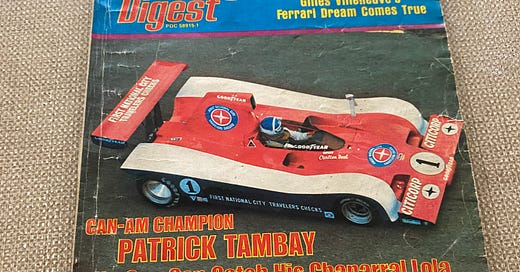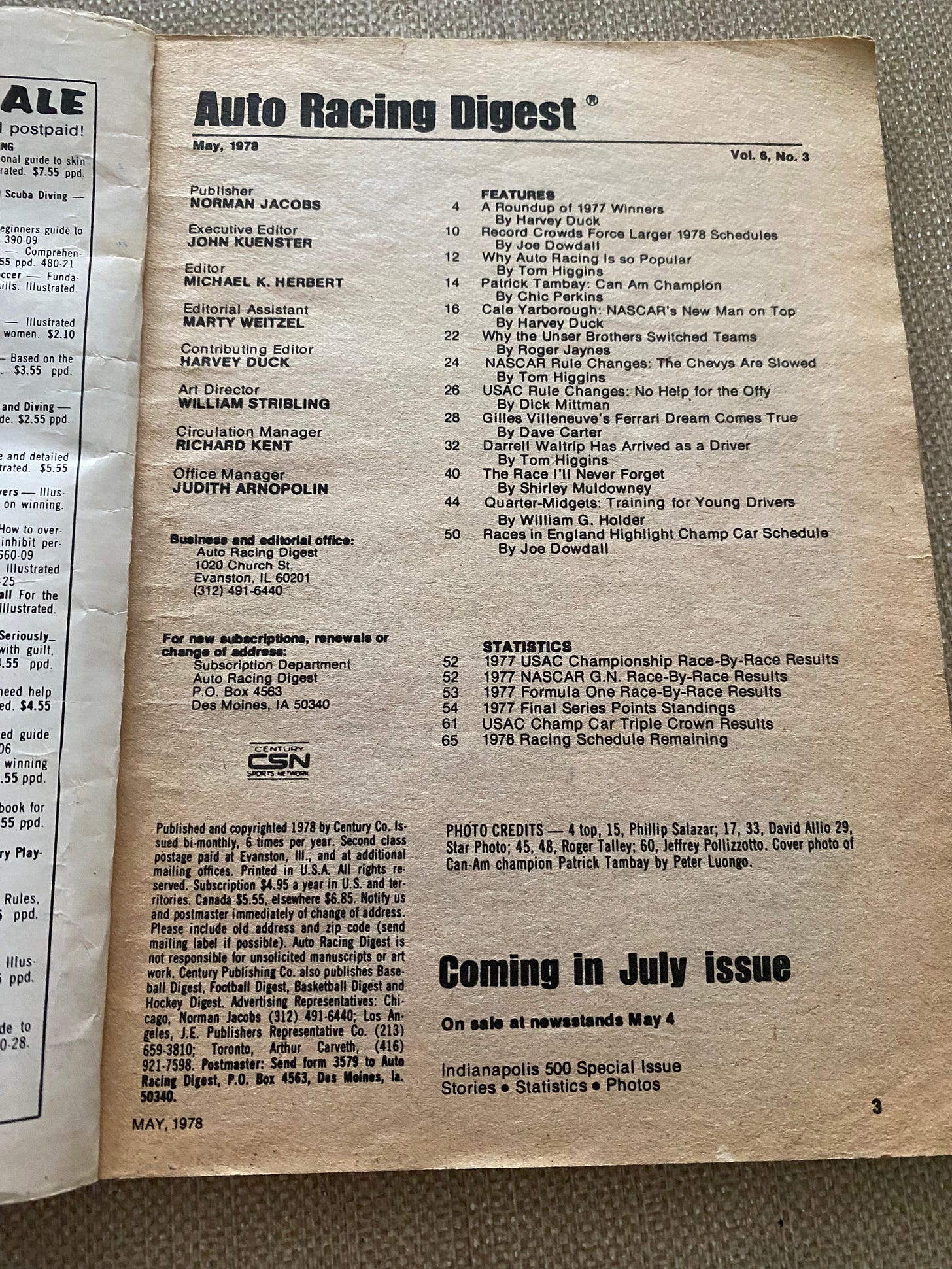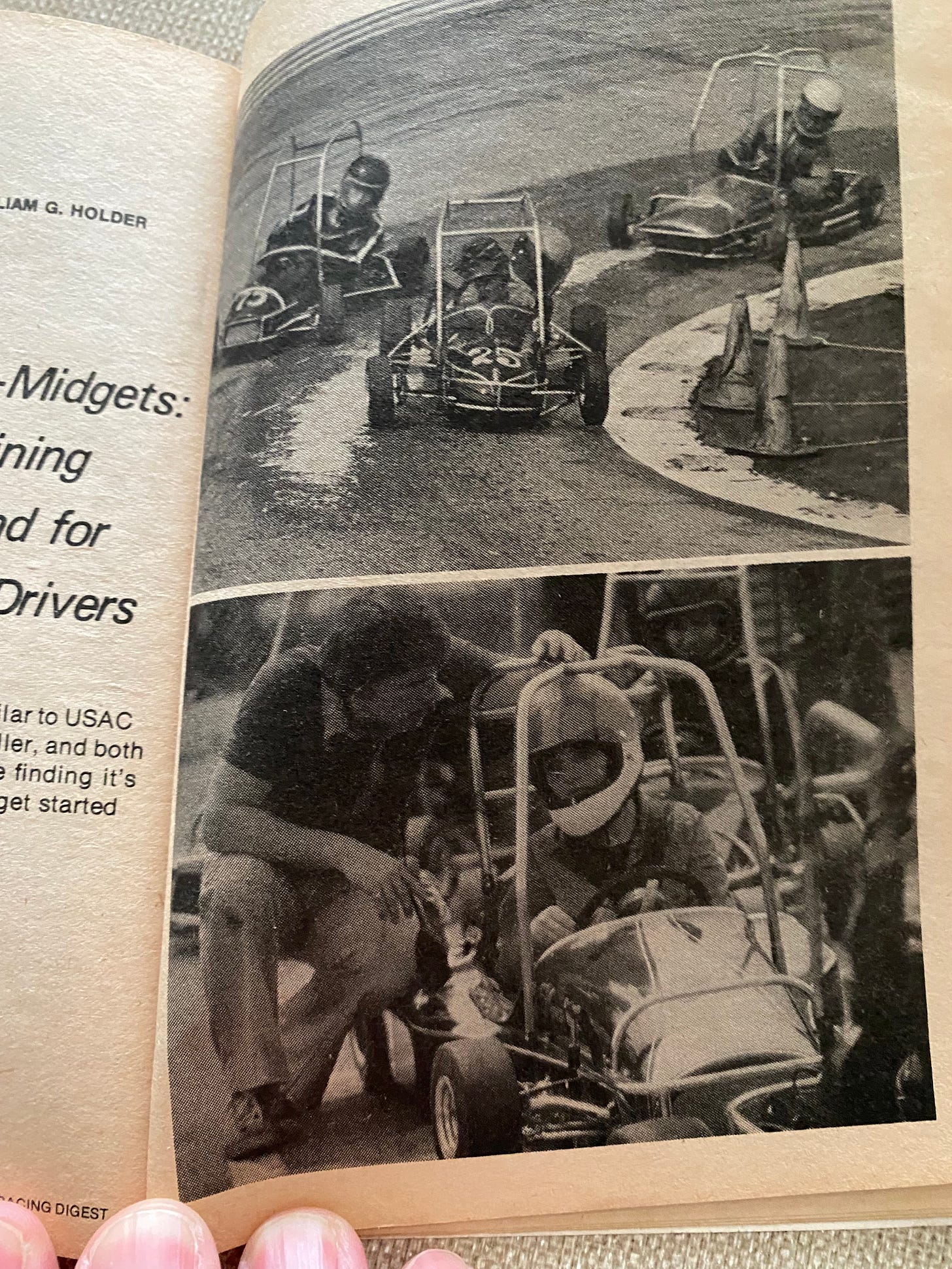May 1978
Racing was a very niche sport in 1978. ESPN did not exist yet, so the only racing that one could see on TV would be any of the small handful of races on Wide World Of Sports or the occasional race that CBS would broadcast. One of the side effects of the sparse number of races on the telly was that no one particular form of motorsports was most prominent among general sports fans. In other words an auto racing publication could easily make a sports car driver its cover subject, it’s not as if such a low profile driving series was in danger of costing potential newsstand sales.
When I was a younger race fan I was drawn to Indy Car largely because the machines were so exotic. That worked as a dramatic contrast to NASCAR, which at the time was still true stock car racing. The models that raced looked nearly identical to the models seen in showrooms, they were just considerably more souped up. That’s why the saying “win on Sunday, sell on Monday” lasted for so long. Sports car racing never interested me all that much, but if you want to talk about exotic looking cars, look no further than the vehicle on the cover. It makes an Indy Car look like a Ford Escort.
There’s not much that’s terribly interesting in this issue; it largely serves as a wrap on the 1977 seasons/preview of 1978 for an assortment of racing circuits. I’ll briefly focus on a few pieces. Darrell Waltrip is one of the inner circle NASCAR legends, both as one of the winningest drivers and from his years as the lead analyst in the Fox booth. People who know him largely from his broadcast days might be surprised to know how transformative a figure he was as a driver. His Fox persona was the “boogedy boogedy boogedy” guy, but when he was a young racer he was one of the first guys with a sense of slick media polish. The veteran drivers sarcastically called him “Jaws” because he never shut up, he was cocky, backed up that cockiness, and was good looking in an era when most drivers seemed to have their faces permanently caked with grime and motor oil. Before too long a driver with Waltrip’s sense of how to play the media game was the norm, not the exception.
Just as with Baseball Digest’s Game I’ll Never Forget feature, Auto Racing Digest had a recurring Race I’ll Never Forget. The driver under the spotlight in this issue was the famous drag racer Shirley Muldowney, who years later would be the subject of the movie Heart Like a Wheel. Not to disparage anyone, but a drag race is a blink and you miss it event; it’s hard to isolate any individual race and call it memorable. For the record, her choice was a race in 1975 in which she attempted to break the then all-time speed record of over 250 miles per hour. The rules state that for a record to qualify, the driver must achieve it twice within a span of 24 hours. Her first attempt succeeded, but she fell short on the second. Now try to imagine what it must entail to go from 0-250 in around 5 seconds. Yikes.
Finally, the article on quarter midget and its usefulness for training purposes caught my eye. If sports cars are exotic, these are the exact opposite. (You can see from the photo below how lacking in safety features these cars are. Even in the modern era midget cars are quite dangerous.) The article focused on two teenage girls, Tricia Johnson and Vicki Shoemaker, and how participation in this circuit could serve as a stepping stone for more women competing in the highest levels of racing. It remains a slow process; Muldowney was an elite drag racer, and Danica Patrick had decent success in Indy Car before her ill-fated move to NASCAR damaged her reputation somewhat. Those two aside, it has been a struggle for women to gain a stronghold in the uppermost levels of racing.
Most Memorable Moment - Chicago White Sox
MLB’s Original 1975 Choice: 1959 White Sox clinch pennant.
My Updated Selection: Scott Podsednik walks it off
The White Sox won the very first game in American League history way back in 1901. One can say that it’s been all downhill ever since. An odd thing about the Sox is that even though their championship drought ran for a similarly epic length as those of the Cubs and the Red Sox theirs did not resonate with the public in quite the same way. The White Sox have long been the second team in the Second City and that is reflected by the fact that it’s difficult to decide on a most memorable moment for that franchise.
The 1959 Go Go Sox captivated the sport; that team helped bring back the stolen base as a weapon and it was also around this time that the exploding scoreboard at Comiskey Park brought some much needed razzle dazzle to the game. I don’t believe, however, that the memories of that club have lasted long enough for that moment to still reign supreme. It would almost be fitting to choose a farcical moment for the ChiSox. Perhaps Disco Demolition Night? Or the 3 games in 1976 in which the team wore shorts? There is a real Liberty Valance print the legend feel to that story. I suspect there are a lot of people who still believe that the Sox wore shorts for an entire summer, but nope, it was only 3 games.
My selection came down to one of two choices. The runner up was Mark Buehrle’s perfect game in 2009, more specifically the home run saving catch that Dwayne Wise made in the 9th inning to preserve the perfecto. But ultimately I will go with the obvious choice and pick a clutch home run on the championship path.
The 2005 World Series came one season after the Red Sox finally ended the Curse Of the Bambino, but the White Sox’s drought had actually lasted one year longer than the Red Sox’s had. Like Boston, Chicago’s breakthrough into the World Series ended in a series sweep that seemed almost inevitable. The run up was not as dramatic as Boston’s was; the White Sox did not vanquish a lifelong rivalry on the way. Victory still must have tasted very sweet for those who had waited decades for the moment and for those thinking of their loved ones who had not lived to see the title. It helped that the biggest WS moment came from an unlikely source.
Scott Podsednik was your basic light hitting center fielder who brought speed and defense. Any offense he would supply would be a bonus. Yet it was he who came up to bat with the game tied in the 9th inning of Game 2 after the Astros had taken the lead with 2 runs in the top of the 9th. Podsednik only hit 42 regular season homers in his career. No matter; any moment can turn someone into a postseason legend and this was Scott Podsednik’s turn. If the ‘05 Sox didn’t already have a Team Of Destiny aura, they did now. The Sox went on to sweep the World Series, winning for the first time since 1917. Recent years have been unkind to the franchise, but the 2005 squad was special and for now they have produced the most memorable moment in franchise history.
A Reward For Stuntpeople
In welcome news, the Motion Picture Academy will introduce a new Oscar for achievement in stunt design beginning with the 2028 ceremony. This is the second new category recently introduced to the Oscar program; a new award for best casting will be presented for the first time in next year’s ceremony. The stunt award has been a long time coming; great stunt work adds so much to the quality of a movie and the men and women in this field are very deserving of recognition.
Being that there are more than two years of lead time before the first stunt Oscar is handed out, the initial details are sparse. As the linked article states, the Academy hasn’t announced if it will be a standard five nominees & a winner award, or if there will simply be an announcement of a winner. Also, who will it go to - the stunt coordinator, the stunt performer, or both? Whatever the final decision is, I continue to give credit to the Academy. They continue to present all of the competitive awards on the live telecast. I still wish they would do the same with the honorary awards, but at the same time I realize that doing so would make an already long ceremony even more of an exercise in endurance. Is it also asking too much to retroactively present stunt awards to Mad Max: Fury Road? (Not to be confused with Furry Road. I mistakenly watched that instead; it was NOT what I expected.)
When You Are Lacking The Journalistic Ethics Of Barstool
Over the past several days Barstool Sports president Dave Portnoy and the various Barstool hosts who spread the false and vile rumors about Ole Miss freshman Mary Kate Cornett have all publicly and unequivocally apologized for their roles in the story’s spread. You can cynically say that they are merely attempting to stay one step ahead of the lawyers, but credit where credit is due. These were no mealy mouthed “I’m sorry if I offended anyone” statements. They have all acknowledged how badly they have screwed up in ruining an innocent young woman’s life.
Contrast that with the response from Pat McAfee and ESPN. So far McAfee has made the vaguest possible statement about how he needs to do better but it was nothing close to a direct apology to Cornett. ESPN itself has been deadly silent; it’s likely that the network’s attorneys are working 24/7 to draft an appropriate response. Nevertheless it is a terrible look when Barstool of all organizations is taking the high road. ESPN can’t hide behind the excuse that they don’t produce McAfee’s show, they only license it. McAfee’s comments aired on ESPN, so they are just as culpable. I’ll say it again, do better.
50 Years Ago - Baretta
In 1975 the era of the TV detective show was still in full swing. The classic form of the genre had several required, or at the very least suggested, elements. The lead actor should be a maverick who refuses to play by the book but dammit, he gets results. He (and it was virtually always a he) needed at least one catch phrase. And he needed at least one gimmick. Baretta clearly filled all of the requirements.
It was actually a show derived from a series that had aired a couple of years earlier on ABC. Toma was based on a real life police detective named David Toma who was a master of disguise. When the show’s star Tony Musante refused to commit to a second season ABC pivoted and took elements of Toma and repurposed the basic concept into a new show with a completely different set of characters. Enter Robert Blake as Tony Baretta, a police detective who conveniently enough was also a master of disguise.
This was one of the clearest examples of the blurring between actor and character. It was hard to judge where Tony Baretta ends and Robert Blake begins. He even used one of Baretta’s most frequent catch phrases “and dat’s da name a dat tune” as a tagline for auto parts commercials that he starred in. That also extended to his career in the years after the show ended. Was he typecast? Virtually every role he had in the post Baretta years would be a similar tough-talking character. The one exception was the role that he played in David Lynch’s Lost Highway, which was absolutely terrifying.
Beyond Blake there are two things for which the show is best remembered. First was that it had a kick ass theme song, sung by Sammy Davis Jr. I understand every reason why TV a theme songs/opening credit sequences have fallen out of favor, but I love a good show opening. The theme song sets a moody atmosphere for the show; one could say an atmosphere that the content of the show does not live up to.
With one exception, I have little memory of any of Blake’s costars. There are a few recognizable names in the cast, but I can’t picture any of them in this show. The one exception? That brings us to the show’s chief gimmick - Fred the cockatoo! I can guarantee that anyone old enough to remember this show can immediately picture Blake wearing a t-shirt and cap with the bird perched on his arm.
Blake’s tough guy image took a dark turn when he was arrested for the murder of his wife. In the end he was acquitted, but not exonerated. After all that time he went to bed with a price on his head.
Closing Laughs
Bottom of the page already? Where does the time go? Thanks again for tuning in, and please be sure to spread the word about this silly little newsletter. All are welcome here. Have a great day and I will see you all again on Wednesday.







